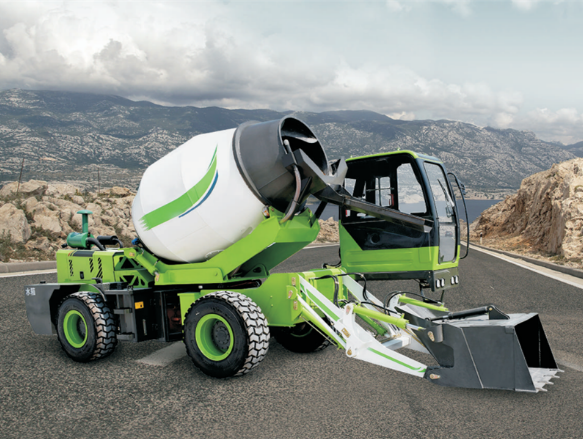The Working Principle of Self-Loading Concrete Mixers
Self-loading concrete mixers are versatile machines used in the construction industry for mixing and transporting concrete to various job sites. These innovative pieces of equipment have gained popularity due to their efficiency, cost-effectiveness, and ability to streamline the concrete production and delivery process. In this comprehensive guide, we will explore the working principles of self-loading concrete mixers, their components, and the benefits they offer to the construction industry.
Working Principles of Self-Loading Concrete Mixers
Self-loading concrete mixers combine the functions of a traditional concrete mixer and a concrete transport truck into a single, compact unit. Their working principles can be divided into several key stages:
1. Loading Aggregates: The first step in the concrete mixing process is the loading of raw materials, which typically include cement, sand, aggregates (such as crushed stone or gravel), and water. Self-loading concrete mixers are equipped with a loading bucket or shovel mechanism at the front of the vehicle. The operator uses this bucket to scoop up the required quantity of raw materials from a stockpile or batching plant.
2. Mixing the Ingredients: Once the raw materials are loaded into the mixing drum, the self-loading concrete mixer's internal components come into action. The mixing drum rotates on its horizontal axis, which is powered by an integrated diesel engine or an electric motor. The rotation of the drum ensures that the materials are thoroughly mixed to create a homogenous concrete mixture.
3. Water Addition: The operator controls the addition of water to the mixing drum through a water tank and a pump system. Water is a critical component of concrete, and its quantity must be accurately measured to achieve the desired consistency. Self-loading mixers allow for precise water control, helping maintain the mix's quality and strength.
4. Agitation and Mixing: As the drum continues to rotate, the materials are continuously agitated, ensuring a consistent and uniform mix. The agitation and mixing process can be adjusted as needed to meet the specific requirements of the job, such as the mix's slump or consistency.
5. Discharge: Once the concrete is thoroughly mixed and ready for use, the operator can control the discharge process. The mixer is equipped with a discharge chute that can rotate and extend, allowing the concrete to be poured directly into the required location, such as a foundation, formwork, or construction site. The operator has full control over the discharge speed and direction.
6. Self-Loading Feature: One of the most significant advantages of self-loading concrete mixers is their ability to load raw materials, mix, and transport concrete without the need for additional equipment or personnel. The self-loading feature allows the operator to manage the entire process independently, reducing the need for a separate loader or concrete transport truck.
Components of Self-Loading Concrete Mixers
To understand the working principles of self-loading concrete mixers, it's essential to be familiar with their key components:
1. Chassis: The chassis forms the base of the self-loading concrete mixer and includes the frame, wheels, and axles. It provides stability and mobility to the machine, allowing it to move to different job sites.
2. Mixing Drum: The mixing drum is the heart of the self-loading concrete mixer. It is a rotating container where the raw materials are loaded, mixed, and stored before discharge. The drum can rotate in both directions to facilitate loading and unloading.
3. Loading System: Self-loading concrete mixers are equipped with a loading bucket or shovel mechanism at the front of the vehicle. This system is used to scoop up raw materials and load them into the mixing drum.
4. Engine: The engine, usually a diesel engine, powers the self-loading concrete mixer. It provides the necessary energy to rotate the mixing drum, operate the hydraulic systems, and drive the vehicle.
5. Hydraulic System: The hydraulic system controls various functions of the self-loading concrete mixer, such as raising and lowering the mixing drum, extending and retracting the discharge chute, and controlling the steering and transmission.
6. Water Tank and Pump: The water tank holds the required amount of water for the concrete mix. A pump system allows the operator to add water to the mix as needed to achieve the desired consistency.
7. Control Panel: The operator's control panel is a user-friendly interface that allows the operator to manage the entire mixing and transportation process. It includes controls for drum rotation, discharge, water addition, and other functions.
8. Cabin: The operator's cabin provides a comfortable and secure environment for the person in charge of operating the self-loading concrete mixer. It is equipped with essential controls, ergonomic seating, and visibility aids.
9. Tires: Self-loading concrete mixers are equipped with heavy-duty tires designed for off-road use. These tires enable the machine to navigate various terrains commonly found at construction sites.
10. Discharge Chute: The discharge chute is an extendable and rotatable component that allows the operator to direct the flow of concrete to the desired location. It can be adjusted to control the discharge speed and angle.
Advantages of Self-Loading Concrete Mixers
1. Time Efficiency
Self-loading concrete mixers are known for their speed. They significantly reduce the time required for concrete preparation and transportation, leading to faster project completion.
2. Cost Savings
By combining the functions of a concrete mixer and loader, these machines reduce the need for additional equipment and labor, translating to substantial cost savings.
3. Versatility
Self-loading concrete mixers are versatile and can be used for a wide range of applications, from small construction projects to large-scale ventures.
4. Quality Control
Operators have complete control over the mixing process, ensuring that the concrete meets the required quality standards.
Applications
Self-loading concrete mixers find applications in various construction scenarios, including:
- Road Construction
- Building Construction
- Infrastructure Development
- Remote Construction Sites
Their adaptability to different project types makes them an indispensable asset for construction companies worldwide.
Conclusion
Self-loading concrete mixers are a marvel of modern engineering. Their ability to efficiently mix and transport concrete while saving time and money has revolutionized the construction industry. As construction projects continue to evolve, these machines will play an essential role in meeting the demands of the industry.
If you want to find a leading construction machinery supplier, just visit [https://www.shengmaomachine.com/contact-us/]















